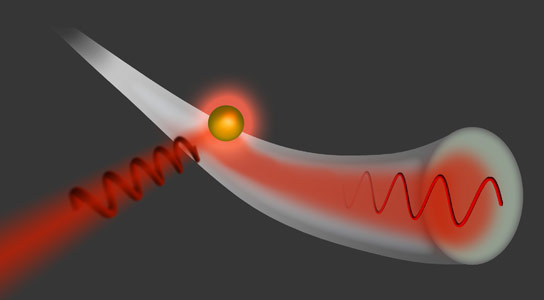
Light hits a gold particle, which then emits light into a glass fiber – in only one direction. Credit: Vienna University of Technology
Using an unusual kind of coupling between spin and the direction of propagation, physicists from the Vienna University of Technology are able to select the direction that nanoparticles can emit light into ultra-thin glass fibers.
How can a beam of light tell the difference between left and right? At the Vienna University of Technology (TU Wien) tiny particles have been coupled to a glass fiber. The particles emit light into the fiber in such a way that it does not travel in both directions, as one would expect. Instead, the light can be directed either to the left or to the right. This has become possible by employing a remarkable physical effect – the spin-orbit coupling of light. This new kind of optical switch has the potential to revolutionize nanophotonics. The researchers have now published their work in the journal Science.
Gold Nanoparticles on Glass Fibers
When a particle absorbs and emits light, this light is not just emitted into one direction. “A particle in free space will always emit as much light into one particular direction as it emits into the opposite direction”, says Professor Arno Rauschenbeutel (TU Wien). His team has now succeeded in breaking this symmetry of emission using gold nanoparticles coupled to ultra-thin glass fibers. The incident laser light determines whether the light emitted by the particle travels left or right in the glass fiber.
Bicycles and Airplane Propellers
This is only possible because light has an intrinsic angular momentum, the spin. Similar to a pendulum which can swing in one particular plane or move in circles, a light wave can have different directions of oscillation. If it has a well-defined vibrational direction, it is called a “polarized wave”. “A simple plane wave has the same polarization everywhere”, says Arno Rauschenbeutel, “but when the intensity of the light changes locally, the polarization changes too.”
Usually, the light oscillates in a plane perpendicular to its direction of propagation. If the oscillation is circular, this is similar to the motion of an airplane propeller. Its rotational axis – corresponding to the spin – points in the direction of propagation. But light moving through ultra-thin glass fibers has very special properties. Its intensity is very high inside the glass fiber, but it rapidly decreases outside the fiber. “This leads to an additional field component in the direction of the glass fiber”, says Arno Rauschenbeutel. The rotational plane of the light wave pivots by 90 degrees. “Then, the direction of propagation is perpendicular to the spin, just like a bicycle, moving into a direction which is perpendicular to the axes of the wheels.”
By checking the wheels’ direction of rotation – clockwise or counter-clockwise – we can tell whether a bicycle moves right or left when looking at it from the side. It is exactly the same as the beams of light in the ultra-thin glass fiber. The sense of rotation of the light field is coupled to the direction of motion. This kind of coupling is a direct consequence of the glass fiber geometry and the laws of electrodynamics. The effect is called “spin-orbit-coupling of light”.
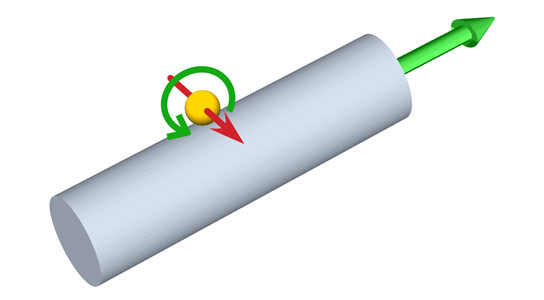
The rotation of the light wave is coupled to the direction of propagation.
Coupling Rotation and the Direction of Motion
When a particle that is coupled to the glass fiber is irradiated with a laser in such a way that it emits light of a particular sense of rotation, the emitted light will thus propagate into just one particular direction inside the glass fiber – either to the left or to the right. This effect has now been demonstrated using a single gold nanoparticle on a glass fiber. The fiber is 250 times thinner than a human hair; the diameter of the gold particle is even four times less. Both the diameter of the fiber and the particle are even smaller than the wavelength of the emitted light.
“This new technology should be easily made available in commercial applications. Already now, the whole experiment fits into a shoebox”, says Arno Rauschenbeutel. “The method could be applied to integrated optical circuits. Such systems may one day replace the electronic circuits we are using today.”
Reference: “Chiral nanophotonic waveguide interface based on spin-orbit interaction of light” by Jan Petersen, Jürgen Volz and Arno Rauschenbeutel, 4 October 2014, Science.
DOI: 10.1126/science.1257671

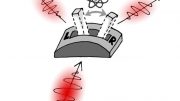
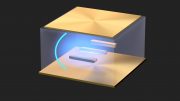
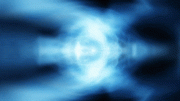
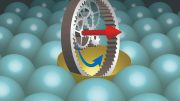
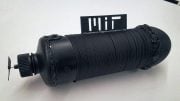
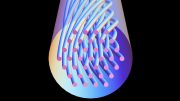

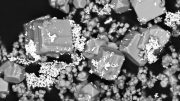
Be the first to comment on "Nanoparticles Allows Physicists to Select the Direction of Light"